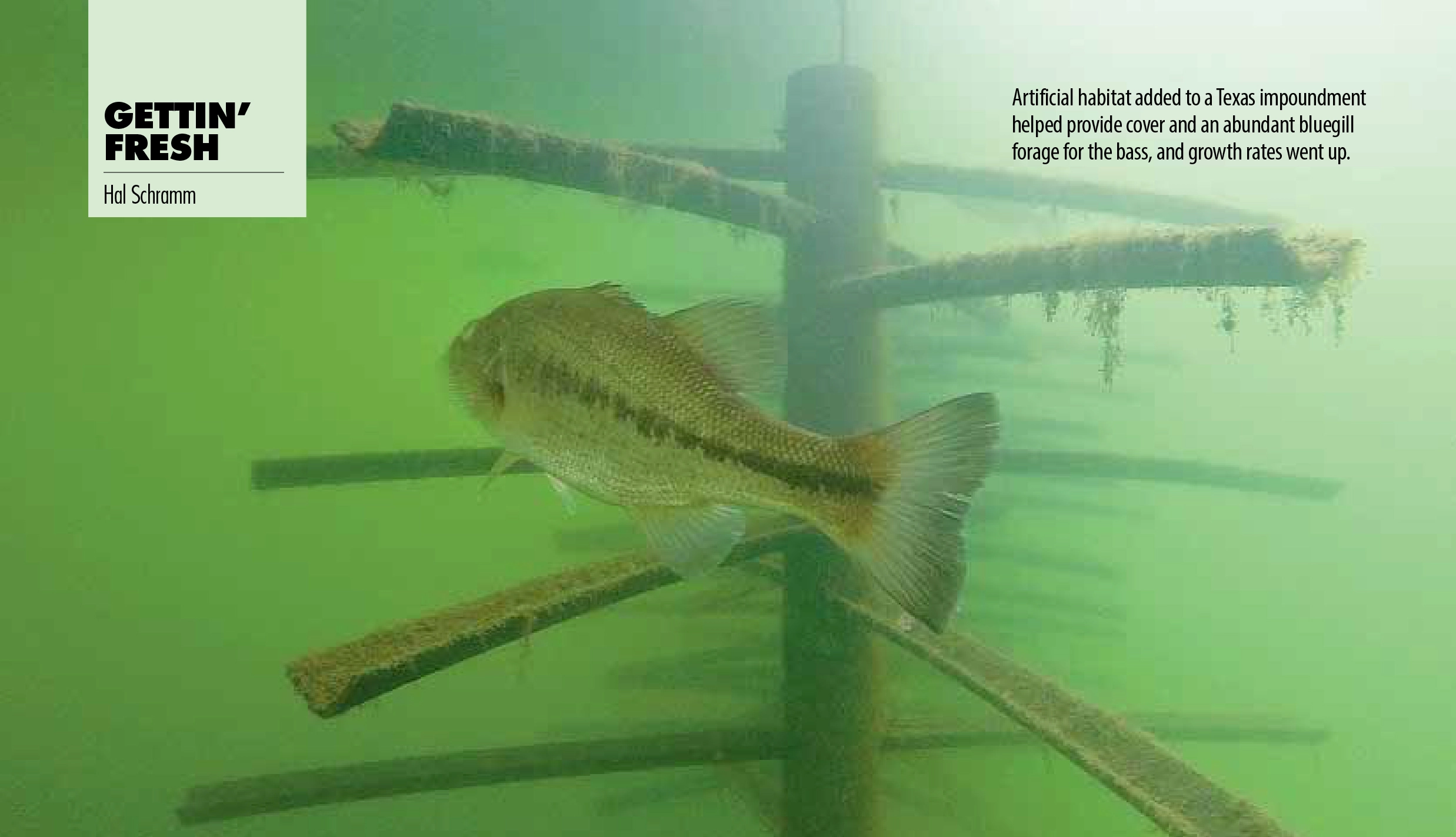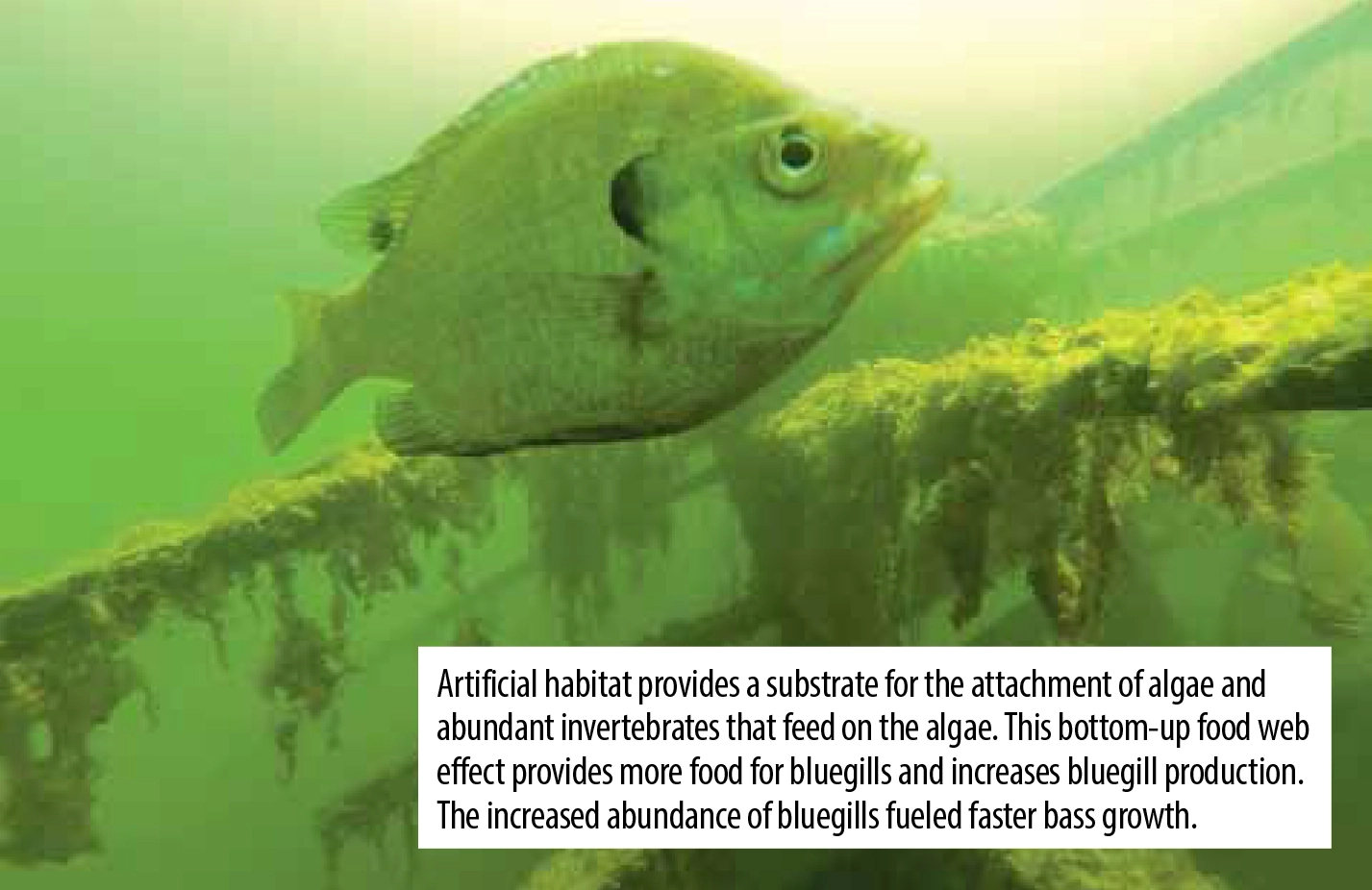
New reservoirs provide exceptional fishing for largemouth bass and other sportfish. While several environmental factors contribute to the high-quality fishing, abundant and quality habitat is a primary factor. With time, many reservoirs fill with sediment, and woody habitat deteriorates. Research by Dr. Brian Graeb and graduate students Jason Breegeman and Chance Kirkeeng at South Dakota State University offers insight into rejuvenating an aging impoundment. The study was conducted on a 110-acre private impoundment in east Texas, managed for trophy bass. The lake was stocked with Florida-strain largemouth bass. In addition to a diversity of forage fish, bluegill, gizzard and threadfin shad, tilapia and red swamp crayfish were intensively stocked to maintain abundant forage. Grass carp were stocked to control aquatic vegetation. The impoundment was not producing bass to the owner’s satisfaction, and the owner stocked 646, 9- to 10-inch Florida bass (about six per acre) in winter 2011-2012. The bluegill population crashed.
Improved Habitat
Management by stocking was not working, so it was time to change course. A variety of Mossback Fish Habitat (https://www.mossbackfishhabitat.com/) structures were installed in shallow and deep water in fall 2014. Numerous structures were added. Thirteen percent of the shoreline had added habitat, which extended into deeper water. The fish community was sampled by electrofishing in spring, summer and fall 2013 through 2016. Sunfish abundance was low before the addition of Mossback habitat, then increased several fold. Bass growth rates increased markedly. They were almost 5 inches longer by age 5 after the addition of the habitat structures, compared to before the habitat improvement.

Insights
A problem with all projects that involve the addition of habitat, such as woody materials, rocks or man-made structures, is determining whether the added cover attracts and concentrates fish or actually improves fish production and abundance. Concentrating fish is desirable if the purpose is to improve angler catch rate, but this could be an undesirable outcome if the purpose is to increase fish abundance. In this study, the goal was to increase largemouth bass growth rates to improve trophy bass potential. The artificial habitat accomplished this by increasing the abundance of sunfish. And, because bass growth rates increased, the addition of habitat likely increased bass production. But there is more to the story. The bluegill abundance increased after the addition of the artificial habitat. The Mossback habitat provides cover for bluegill, but it also provides abundant substrate for the aquatic invertebrates that are the food of bluegills. Bluegills, like most sportfish, live where they have food and appropriate cover. The artificial habitat was also a good habitat for bass, created an area of abundant sunfish forage and provided favorable conditions for efficient feeding by an ambush predator. It also provided good habitat for crayfish, an important forage for bass in this impoundment. Previous research found that cover benefits bass feeding, but cover that is too dense can impair bass feeding. In this case, the cover density was desirable, and the bass could “stay at home” to benefit from the abundant forage, conserving energy that could be directed to growth. It is important to note that the addition of habitat was extensive; 20% of the lake area had added habitat. This is a far greater amount of added habitat relative to the area of the impoundment than used in any other habitat improvement project of which I am aware. Before this habitat improvement-effort project, the private lake was managed by stocking — intensive forage stocking and the addition of more Florida bass when the bass fishing wasn’t good bass. The forage stocking apparently did little good without habitat for the forage, and the bass stocking further depleted the forage. To make matters worse, the impoundment owner had tried to eliminate aquatic vegetation, habitat that provides cover and increases forage for bluegill. The increases in bluegill abundance and bass growth rate were substantial. The study, although well designed and conducted, only measured short-term fish responses. Longer-term assessments are in progress.
